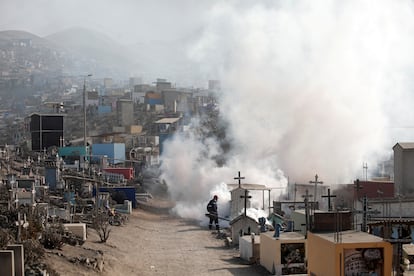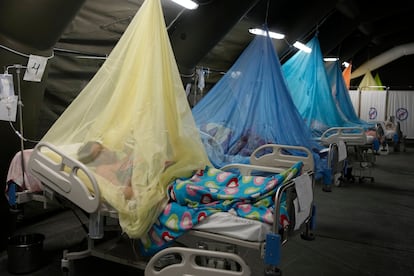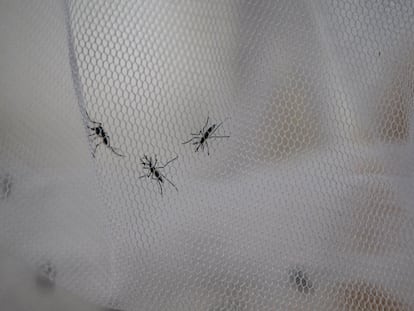Peru declares a health emergency in 20 regions after 32 deaths from dengue
The epidemic has registered over 31,000 cases so far, and the country has the highest fatality rate in South America. Authorities have been slow to admit the situation

Since the 1990s, the dengue virus has been a latent threat to Peruvians. But as often happens with other emergencies, it usually catches the government off guard; authorities spring into action in a race against the clock when the situation has already escalated. After an alarming 2023, with 18 deaths and 12,264 infections due to the Aedes aegypti mosquito, specialists had issued clear recommendations on what to do to prevent similar future harm to public health. Among these recommendation were prevention measures, purchase of medicines, communication strategies, improvement of infrastructure, training of professionals, and greater access of the population to safe drinking water, since the mosquito deposits its eggs in stagnant waters. However, the authorities’ response has once again been slow.
On February 5, when cases had already skyrocketed and a dozen deaths had been reported, Health Minister César Vásquez Sánchez denied that there was an epidemic, and said it was still not necessary to declare an emergency. Three weeks later, the government has backtracked and admitted the crisis by declaring a state of emergency in 20 regions for a period of 90 days. In just two months, dengue fever has killed more Peruvians than in all of 2023: 32 confirmed deaths, with eight more under investigation and 31,364 infections. Compared with the same period of time last year, there has been an increase of 97%.
“There is not yet an epidemic situation in Lima, but we cannot wait for an unsustainable situation. That is why instead of declaring an emergency in the five regions where there are the most cases, we have decided to extend it to the 20 that are at imminent risk and where contagion can grow,” said Minister Vásquez. According to the National Center for Epidemiology, Prevention and Disease Control, the regions where the virus has spread the most in the first seven weeks of the year are: La Libertad (4,207), Piura (4,155), Ica (3,313), Áncash (2,462) , San Martín (1,633) and Lima (1,495).

The coastal region of La Libertad had barely registered 14 cases at this point in time last year. Áncash only had three infected people and Lima, 22. The forecasts are not encouraging at all. And the health minister has not been able to conceal it: “March and April are going to be much tougher,” he said briefly about the surge of the contagion curve.
Adding to the healthcare deficiencies are the weather conditions: cities have become ovens, and the El Niño phenomenon has brought intense rain. As the temperature increases, the regiment of adult mosquitoes is expanding. Their development, which previously took a week, is now down to three days on average. In Peru there are regions where running water is scarce, and people store water in buckets and other containers that can end up becoming a source of dengue. According to the National Superintendency of Sanitation Services (Sunass), 3.3 million Peruvians still lack access to a public drinking water network, and 6.4 million do not have sewage connections.
For infectious disease specialist Juan Carlos Celis, the most important thing is to ensure hospital care rather than fumigation. “It is already late for fumigation campaigns. What is needed are complete dengue units: 12 beds, five doctors, five nurses and 10 technicians. All trained. For 30 hospitalized patients, a minimum of two complete teams. Unfortunately, history repeats itself,” he notes.
Three of the four known dengue serotypes are currently circulating in Peru: DENV-1, DENV-2 and DENV-3. The most common symptoms of dengue are a high fever, muscle pain, a rash, dehydration and headaches. If not treated promptly, complications can set in and compromise vital organs, in addition to triggering effects on the nervous system and leading to a significant decrease in blood platelets.
According to the Pan-American Health Organization, until the sixth week of 2024, Peru registered the highest fatality rate in South America and the third in the entire continent: 0.1167, just below Panama (0.1916) and Honduras (0.1411). These days, with the wind blowing against it, the health ministry is attempting to change the curve through training and talks on how to identify and eradicate mosquito breeding sites.
Sign up for our weekly newsletter to get more English-language news coverage from EL PAÍS USA Edition
Tu suscripción se está usando en otro dispositivo
¿Quieres añadir otro usuario a tu suscripción?
Si continúas leyendo en este dispositivo, no se podrá leer en el otro.
FlechaTu suscripción se está usando en otro dispositivo y solo puedes acceder a EL PAÍS desde un dispositivo a la vez.
Si quieres compartir tu cuenta, cambia tu suscripción a la modalidad Premium, así podrás añadir otro usuario. Cada uno accederá con su propia cuenta de email, lo que os permitirá personalizar vuestra experiencia en EL PAÍS.
¿Tienes una suscripción de empresa? Accede aquí para contratar más cuentas.
En el caso de no saber quién está usando tu cuenta, te recomendamos cambiar tu contraseña aquí.
Si decides continuar compartiendo tu cuenta, este mensaje se mostrará en tu dispositivo y en el de la otra persona que está usando tu cuenta de forma indefinida, afectando a tu experiencia de lectura. Puedes consultar aquí los términos y condiciones de la suscripción digital.
More information
Archived In
Últimas noticias
Most viewed
- Sinaloa Cartel war is taking its toll on Los Chapitos
- Oona Chaplin: ‘I told James Cameron that I was living in a treehouse and starting a permaculture project with a friend’
- Reinhard Genzel, Nobel laureate in physics: ‘One-minute videos will never give you the truth’
- Why the price of coffee has skyrocketed: from Brazilian plantations to specialty coffee houses
- Silver prices are going crazy: This is what’s fueling the rally










































